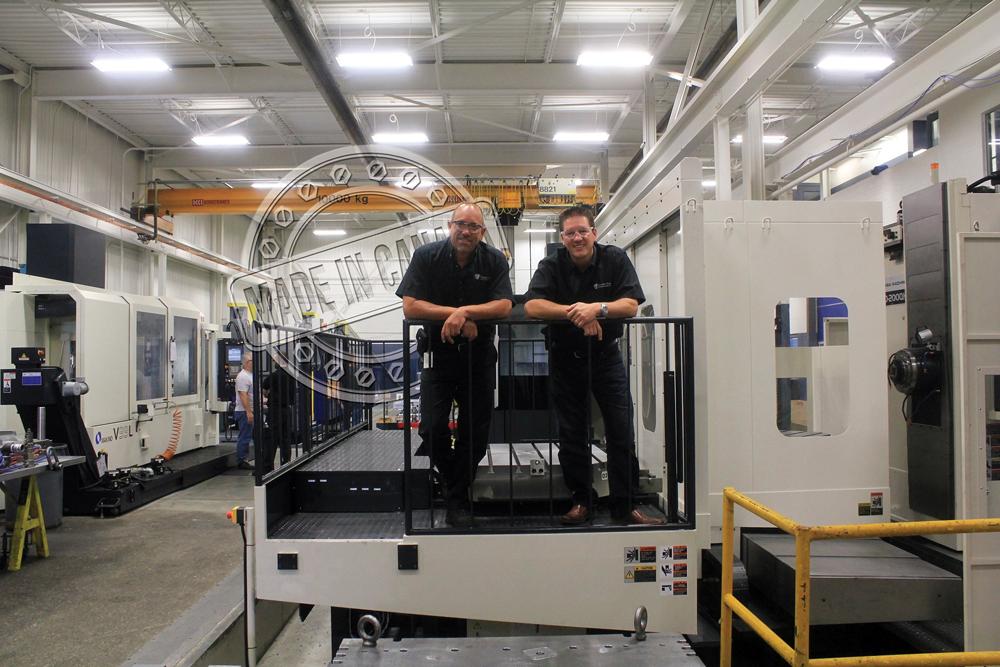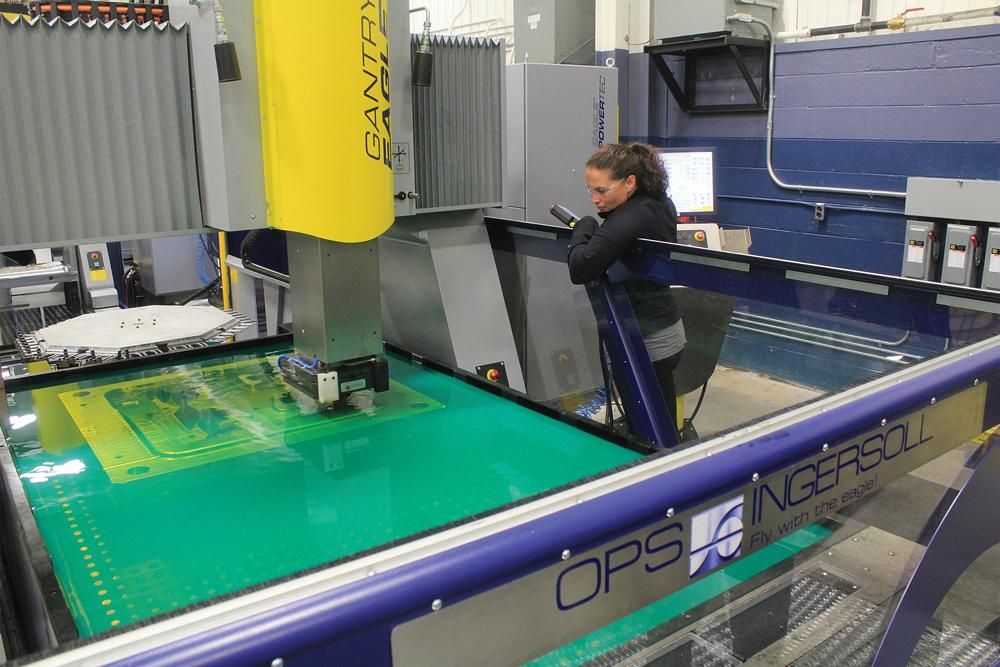- FMA
- The Fabricator
- FABTECH
- Canadian Metalworking
Life as a 21st Century Moldmaker
Ontario shop takes risks, invests in people and processes to improve productivity
- By Joe Thompson
- November 9, 2015
- Article
- Made In Canada

Cavalier Tool & Manufacturing President Brian Bendig (right) and CNC Leader Mike McNaughton stand on a machine access platform in the company’s 50,000-sq.-ft. shop.
Walking into the Windsor, Ont., facility of Cavalier Tool & Manufacturing is like being in the eye of a moldmaking hurricane: Everything is calm in the walkways, but around you is plenty of motion, with every machine running, making chips, being productive. Really productive.
Established in 1975 the company has an early history that is similar to that of many shops in the area. When the automotive industry was booming, the shop was busy; when the market cooled, so did Cavalier’s business.
It was how the industry worked.
Windsor today is still home to the most tightly grouped number of moldmakers in the country. It’s ubiquitous, almost cliché. But the industry has changed, especially since the recession in 2009. Companies that had been operating in the traditional fashion started to fall by the wayside, closing their doors after decades in business.
Cavalier didn’t want to be another statistic, and that led to change.
Today Cavalier still is known for building medium-sized to large molds for, yes, automotive, but the company also has diversified its product offering to include mold creation for recreational, agricultural, and commercial customers.
Its customer base reads like a who’s who of brand names, and they come to Cavalier for a reason, says Cavalier Tool President Brian Bendig.
“It’s our goal as a company to be a model of moldmaking efficiency,” said Bendig, who is the second generation of his family to run the shop. It was Bendig’s father, Ray, and two partners who first opened the shop 40 years ago.
“Our customer base comes to us because they need what we provide in terms of production and care,” said Bendig. “We like to be challenged. We feel that with the people we have in place and the investments we’ve made in equipment that we can solve any mold problem for any customer.”
You hear that mantra a lot from Bendig. The company’s strategic plan for success mainly revolves around three things: people, process, and equipment. By striving for continual improvement in all three of these areas, he believes that Cavalier will be able to continue its current growth cycle and also push the boundaries of what a 21st century Canadian moldmaker can accomplish.

EDM department operator Christine Sawyer moves the OPS-Ingersoll Eagle electrical discharge machine into position before cutting.
Brave New World of Manufacturing
The manufacturing world has changed dramatically in the 40 years since Cavalier first opened its doors and began making molds. Supply chains, competition (both domestic and foreign), and customers have all changed, forcing Cavalier to change as well.
In particular, the moldmaking industry has been hard-hit in this part of the country. Gone is the simple work, moved to China and other lower-cost locations. This shift in manufacturing, in combination with the recent recession, caused Cavalier to rethink its business … every part of its business.
“If we want to change the way people think about manufacturing, we need to start now,” said Bendig. “At Cavalier that means a process of continual improvement, innovation, and automation.”
It’s a plan that seems to be working.
In just five years the company has grown its revenue from $8 million per year to more than $30 million. The goal? Double its sales in the next few years.
That means more injection, structural foam, tools with gas assist, multishot, thermoset, compression, and prototype jobs. This work is currently all performed in the company’s 50,000-sq.-ft. shop, which runs 24/7. To reach its sales goals, Cavalier will need to expand the shop, and it’s already planned.
“It all comes down to having the right people and the right equipment at the right time,” said Bendig. “When you have the capability like we do to set up machines and run them constantly, whether it’s with a palletizing system or with parts loaded into a tombstone, it frees you up to perform other work. This reduces costs and increases productivity at the same time.”
Bendig recognized early in his tenure as president that to be at the top of every customer’s contact list the company had to invest in the newest and most complex technology that was available. This has led to a program that continually analyzes the current technology in the shop and replaces older equipment with newer, faster, automated machinery when it’s available. On average, three or four new pieces of equipment are brought into the shop every year.
This type of buying is a large financial outlay, but one that is necessary to both the present and future of the shop, according to Bendig.
“If having a piece of equipment means that we can do something our competition can’t, then it’s simply the cost of doing business,” he said. “Some shops might say they can’t afford to update machinery in this way, but for us, we feel we can’t afford not to.”

The company’s gantry-style EDMs have high axis travel speed and large work tanks for the efficient manufacture of medium-sized to large molds.
One example of Cavalier’s “spend money to make money” strategy is its electrical discharge machining (EDM) operation. In 2012 the company purchased an OPS-Ingersoll Eagle 1200, a gantry-style EDM sinker, becoming one of the first shops in North America to have one on its floor.
“Making an investment in this one EDM alone saved us more than $100,000 in consumable and operational costs in the first year of operation,” said Bendig.
Two more OPS-Ingersoll Eagles (the larger 1400 models) have since been added, sitting together in a line with the other EDMs, which enables all three to be monitored by the company’s EDM experts.
This year Cavalier added an OPS-Ingersoll Eagle V9 high-speed, simultaneous 5-axis milling machine that can create graphite electrodes in a single setup.
“This latest purchase is a big deal for us,” said Bending. “Not only can we create most of our electrodes in a single setup now, but we can also make them much faster. It’s a good example of how we research a tool that can help us, install it on the shop floor, and use it to improve the overall process and reduce costs.”
In the past few years the company also purchased complex multiaxis machining centers, large horizontal machining centers (HMC) designed to machine a large mold plate in one setup, horizontal boring mills, and gun drills.
Sometimes it was simply to improve a machining process, and sometimes these purchases, for example two IMSA gun drills added in 2013 and 2014, were brought in to bring work back into the shop that was being outsourced.
Customizing Machines
The continual improvement process doesn’t end once the equipment is installed on the shop floor, either. That’s when the true changes are just beginning.
When chips from the company’s Toshiba 4-axis boring mills were coming too close to other machines and walkways, the company decided it needed to build custom shrouds around the machines. These enclosures were designed and built in-house and added to the machines.
This is just one example of many around the shop of the company’s willingness to change the status quo and not be afraid of change.

Large molds can be machined in one setup because of Cavalier’s investment in CNC machining technology.
“If you aren’t actively seeking out ways to improve, you already are falling behind,” said Bendig.
For Cavalier this means improving and empowering its employees, not just its equipment. Continual training that uses employee input as a basis helps new employees integrate faster and enables the company to put employees in the best position to succeed.
“If we hire someone with a great background in computers and technology, we should be thinking, in the long-term, about how that person will one day be working with our CAD/CAM team,” said Bendig. “Not everyone in a manufacturing company is going to be running a machine. I think that’s where the general public needs some educating. We definitely need machine operators, but we also need designers, engineers, and sales staff.”
The company’s cyclical program of machine replacement ensures that it will not fall behind other moldmaking shops, no matter where they are located in the world.
“Our competition today is not just down the street,” said Bendig. “If we want to reach our goals — and not just our sales goals but our strategic goals -- then we need to keep on top of trends in machine tools, cutting tools, and software.”
Continual Improvement
The company spends a lot of time and energy examining and re-examining its processes. Spindle utilization and other metrics help the production staff refine processes, especially as new technology is integrated. Collaboration between the design staff and the manufacturing teams, and even the sales staff, also helps Cavalier develop better molds in less time.
And that’s what business really is all about at Cavalier. Moldmaking. The shop still sits in the heart of the country’s traditional moldmaking industry, but it is operating just a little differently than everybody else.
subscribe now


Keep up to date with the latest news, events, and technology for all things metal from our pair of monthly magazines written specifically for Canadian manufacturers!
Start Your Free Subscription- Trending Articles
- Industry Events
MME Winnipeg
- April 30, 2024
- Winnipeg, ON Canada
CTMA Economic Uncertainty: Helping You Navigate Windsor Seminar
- April 30, 2024
- Windsor, ON Canada
CTMA Economic Uncertainty: Helping You Navigate Kitchener Seminar
- May 2, 2024
- Kitchener, ON Canada
Automate 2024
- May 6 - 9, 2024
- Chicago, IL
ANCA Open House
- May 7 - 8, 2024
- Wixom, MI















